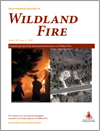
International Journal of Wildland Fire
Volume 29 Number 2 2020
WF18063The psychosocial impacts of wildland fires on children, adolescents and family functioning: a scoping review
This scoping review examined information about the impacts of wildland fires on children, adolescents and family functioning. Impacts of wildland fires are related to age, gender, time and property loss. Future investigations need to focus on the family unit, children and adolescents as primary participants within a disaster framework.
WF19039Current and future patterns of forest fire occurrence in China
This study analysed current and future potential patterns of forest fires at a national scale in China. Under projected climate change, the probability of fire could substantially increase in the not-too-distant future. Spatially, increased fire probability is projected to shift northward in China. The potentially altered fire probabilities would likely pose challenges to land managers in maintaining health and functions of forest ecosystems.
WF19070Likelihood and frequency of recurrent fire ignitions in highly urbanised Mediterranean landscapes
We used Hurdle models to analyse the influence of human and biophysical variables in predicting both the likelihood and frequency of fire recurrent ignition points. They showed a negative relationship with population and road density and a positive relationship with land-cover variables. Road density was the strongest predictor of recurrent fire ignitions, followed by the presence of shrublands and grasslands. NDVI and NDWI were also good predictors of fire recurrence.
WF19066Wildland fire emission factors in North America: synthesis of existing data, measurement needs and management applications
An online database, the Smoke Emissions Repository Application (SERA), was created to provide summaries of wildland fire emissions factors to be used in smoke management and emissions inventories. Based on identified information needs, we offer recommendations for future studies, including greater emphasis of emissions studies in long-duration smouldering fires.
WF19066 Abstract | WF19066 Full Text | WF19066PDF (382 KB) | WF19066Supplementary Material (521 KB) Open Access Article
WF19043Forest stand and site characteristics influence fuel consumption in repeat prescribed burns
In the present study, we quantify the consumption of ground and surface fuels in first-, second- and third-entry prescribed burns. We find that the following characteristics influence fuel consumption: total fuel load; proportion of overstorey pine; slope; canopy cover; basal area of live trees; burn number; and stand.
We propose a new method to generate an ensemble of wildfire simulations to predict fire spread. Ensembles are evaluated with probabilistic scores that are new to the wildlfire community. Application to seven fires supports that the method may be used with the limited data availability typical of an operational context, provided that we can access sufficient computational resources.
WF19041Object-based post-fire aerial image classification for building damage, destruction and defensive actions at the 2012 Colorado Waldo Canyon Fire
Classifying post-fire imagery for building damage, destruction, and defensive actions at the 2012 Colorado Waldo Canyon Fire showed a favourable performance when compared with ground-based assessments. This work highlights the importance of including post-fire imagery in post-fire assessments and the need to account for defensive actions in post-fire studies of the wildland–urban interface.
WF19067Ecosystem management applications of resource objective wildfires in forests of the Grand Canyon National Park, USA
 , Peter Z. Fulé, David W. Huffman, Andrew J. Sánchez Meador and John Paul Roccaforte
, Peter Z. Fulé, David W. Huffman, Andrew J. Sánchez Meador and John Paul Roccaforte
Resource objective wildfires improved ecological conditions by maintaining intact conditions in pine-oak forest, restoring forest structure in mixed-conifer forest, and shifting spruce-fir forest to more open and heterogeneous forest structure conditions, all of which promoted a more fire- and climate-resilient species composition.



